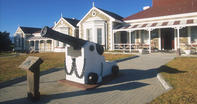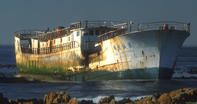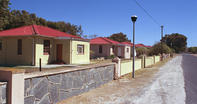Early Military Establishment

The years from 1936 to 1960 were the proudest in Robben Island's long and mostly tragic history. These were the military years, when army and naval troops lived on the island and protected the mainland from an anticipated invasion by the Germans. In 1933, Adolf Hitler rose to power in Germany and plunged the world into a global struggle, which would culminate into World War II. Back in South Africa, allegiances were divided.
The English were clearly on the side of Britain and the allied powers. The Afrikaners, for their part, generally favoured the German cause, or advocated a neutral stance in the European conflict. This caused a rift in the coalition government between J.B. Herzog’s Nationalist Party and Jan Smuts’ South African Party. At this time, the Head of Defence was a devoted Nationalist named Oswald Pirow, and he used the tensions brewing in the Northern Hemisphere as a good excuse to shore up South Africa’s military defenses.
Whether this decision was in anticipation of a German attack or in preparation for a civil war against the English is difficult to determine. Pirow declared that Robben Island’s strategic position at the entrance to Table Bay made it the ideal location for a new military base, and declared the entire island to be military property. A gun battery was subsequently transferred from Signal Hill to Robben Island, largely because the concussion caused by the firing of these guns on the mainland tended to shatter windows in Green Point. Additional plans were also drawn up to strengthen the island’s defences.
The Robben Island Military Base

World War II officially broke out in 1939. With Japanese ships prowling the Indian Ocean and the unseen threat of German U-boats menacing the Atlantic, it became imperative that the safety of Cape Town be upheld. Accordingly, the Department of Public Works was ordered to fortify the island. 150 000 tons of building material was laboriously shipped over the sea, and teams of labourers were soon building roads, barracks, a landing strip, observation towers, outlooks, rifle posts, troop compounds and the other paraphernalia of battle.
Most of the old buildings were also demolished, and the rubble was used to build a new harbour at Murray’s Bay. Finally, a desalination plant was constructed to supplement the island’s traditionally-poor water supply. The two gun batteries that were constructed eventually boasted an assortment 6” and 9.2” calibre guns; the Cornelia Battery overlooked the Blouberg channel and the De Waal Battery protected the entrance to Table Bay.
During the war, four 3.7” and two 40mm Bofors Guns were also added to the arsenal, along with a dummy battery that was to act as a decoy. Along with the batteries at Simonstown and Llandudno, it was hoped that these coastal defences would stave off any hostile invaders and cables were laid along the ocean floor to detect invading U-boats.
There was never an actual attack on Cape Town and the guns were never fired in battle. They were fired for tests and drills, however, and on one occasion, they set the surrounding Bluegum trees alight and caused a terrific bonfire. However, German U-boats did prowl the waters off the Cape and harried several fleets of allied ships as they sailed up the West Coast.
Home to Many Troops

During the war and years beyond, thousands of military troops made their home on Robben Island. Gunners, engineers, medics, chaplains, infantry and naval troops from both the British and South African forces all served on Robben Island, either in active duty or as part of their training. Additionally, soldiers of colour from the re-formed Cape Corps and female soldiers from the Women’s Auxiliary Army Service (WAAS),
Women’s Auxiliary Air Force (WAAF) and the South African Women’s Auxiliary Naval Service (SWANS) were also used to bolster the country’s war effort when the supply of men ran low. Once the war ended in 1945, most of the troops were withdrawn from Robben Island. The military still held onto the strategically important outpost until 1960, however, and used the infrastructure they had built as a Coastal Artillery School.
The many barracks, outlooks, rifle posts and observation towers fell into disuse, but a small community of semi-permanent residents took over the old ‘Irish Town’ and made the village their own. Several people have subsequently written of an idyllic childhood spent on Robben Island, safe yet isolated, where the only action was the occasional military manoeuvre and the booming of the battery guns that were sometimes fired as part of a drill.
By David Fleminger